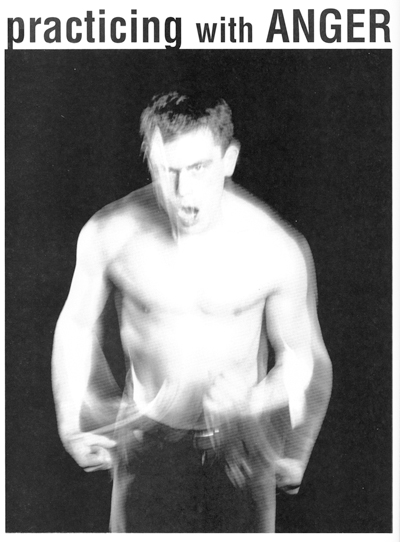
As practitioners, we sometimes feel as if we must behave as diplomats for Buddhism, always acting gentle and not getting angry. Do you think Buddhists have more trouble expressing their anger than non-Buddhists?
People have one of two problems with anger, as they do with any emotion. Either they’re indulgent in the expression of it, or they’re afraid of it; either they’re spilling the emotion, or it’s there and it’s affecting them but it’s being pushed away. Many Buddhists get very skilled at pushing anger away, at sitting at a distance from their anger, but it’s not extinguished. They need help bringing it back into the center of their awareness and owning it again. Of course, some Buddhists, like other people, are just spilling anger, self-indulgently, and then it’s a problem of ego and of learning how to use some restraint.
How does the view of anger differ between Western psychotherapy and Buddhism?
The Buddhist teachings suggest countering hatred with love. This takes anger pretty much at face value – as an unwholesome mental state, a kind of noxious emotion, like poison. That notion of anger is exemplified by one of the Buddha’s first disciples, Angulimala, who murdered victim after victim. Run-of-the-mill late-twentieth-century anger is positioned a little differently. It’s a little more perverted. In psychotherapy, it’s the disguised message of anger that is looked for – the attachment or love that’s underneath the anger, or anger as a perverted form of aggression in psychotherapy. Aggression is seen as a good thing necessary to break through an obstacle. Frustrated aggression is a problem, but aggression itself is not a bad thing.
Tibetan Buddhism, in particular, pays a lot of attention to the transformation of anger, and to the idea that anger is a kind of energy that can be harnessed. In some of the teachings, anger is not even considered to be a negative thing.
It’s similar in psychotherapy. The crucial thing about anger is that it is a clue to where someone is blocked. And you have to salvage the energy. Otherwise, you might be wiping something out that’s precious. When I’m working as a therapist and people come in with anger, I don’t ordinarily try to counter it with love, as you would do in traditional Buddhist teachings. I see anger as connected to a kind of life energy. Whenever you’re leaving some vital part of yourself off to one side, there’s a kind of depletion of energy. That feeds into a willingness to let someone else lead you. It’s a kind of sapping of the aggressive energy that’s necessary for true involvement in the world. So I look for the aggressive life energy that’s necessary for making contact. How is the person shutting him–or herself down?
Is there a difference between dissolving anger and transforming it?
Creating a space in which anger can actually dissolve is the same as transformation. In Western psychotherapy, the thrust of the therapist’s position is to not make judgments about material the client or patient presents. The analyst is supposed to be equidistant between id, ego, and superego: that means that the analyst sits in a position of neutrality and doesn’t rush to judgment, even in the face of terrible expressions of rage. From a Buddhist point of view, one could say that the ideal stance, even in the face of overwhelming negative emotions, is the same – not to rush to judgment – and to make space for whatever is being presented. When I’m functioning as a therapist and someone comes in with their anger pushed off to the side, my impulse is to try to draw that anger back into them. Usually, they have a fundamental fear that if they truly express their anger, they will be disdained or rejected.
In the ideals both of a teacher and of a mother, there’s the notion of creating a sphere of unconditional love in which you can reveal yourself, whether anger or anything else arises, without fear of rejection. As a therapist, can you provide this?
I think this idea of unconditional love is a little dangerous, because the way most people try to provide it – whether mothers or therapists – is by being fake. Who can really love everyone all the time? So if you’re trying to offer unconditional love and it’s not real, then the other person experiences you as a fake, and it’s no longer a safe environment. When it’s real, it’s very beneficial. But I find it more useful to talk about what Donald Winnicott calls being a “good enough” mother or a “good enough” therapist, which means that you don’t have to be completely loving. We can be loving enough. And it’s actually in the disappointments or failure of that less-than-perfect environment that a person evolves: if the mother or the therapist is good enough but not ideal, the person can develop his or her own capacity for tolerance.
What makes you angry?
Being misunderstood.
What do you do when you’re angry?
I try to first feel the feeling, both in my mind and in my body, before I act. That’s hard for me. I try to notice the impulse to act or to speak. Then I try to be judicious in my response. Sometimes that means going with the energy of the anger, and sometimes thinking better of my impulse. I don’t know how I make that decision. What I really have to work on is when the anger percolates. I try not to be so judgmental about anger, to say, “Okay, I’m angry. It’s not the end of the world.” But when I see that I’m brooding, I have to be more meditative with it, to find it in my body and just be with it.
Read Mark Epstein’s “Stopping The Wind.”
Thank you for subscribing to Tricycle! As a nonprofit, we depend on readers like you to keep Buddhist teachings and practices widely available.